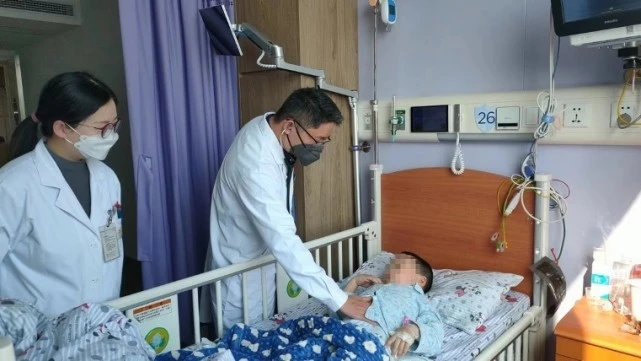
Shanghai Pediatrician: Beware of these two “inflammatory storms” in children after a new crown infection
A 2-year-old baby, Xiaoxiao (pseudonym), suddenly broke out with a multisystem inflammatory syndrome 20 days after her new coronary infection, with a generalized rash, abnormal liver function, and a marked increase in tumor necrosis factor.
Similarly, a 10-year-old girl, Mengmeng (pseudonym), was thought to have recovered 3 weeks after her new coronary infection, but unexpectedly developed myocarditis, with troponin up to 400 times the normal value.
On January 30, the reporter learned from Xinhua Hospital affiliated with Shanghai Jiaotong University School of Medicine, the hospital recently received the above two cases. The director of the hospital’s pediatric cardiovascular department, Chen Zhuo, reminded parents to be especially careful of children infected with the new crown after the emergence of two “inflammatory storm” – multi-system inflammatory syndrome and viral myocarditis.
The hospital revealed that 20 days after the 2-year-old baby Xiaoxiao “Yang”, suddenly began to cough constantly, continued to cough for 3 weeks, followed by recurrent fever again, Xiaoxiao parents did not care at the time, until Xiaoxiao appeared rash all over the body, then rushed to Shanghai Xinhua Hospital for medical treatment.
Blood test results showed that Xiaoxiao’s white blood cells and C-reactive protein were significantly elevated, liver function was abnormal, ghrelin was significantly elevated, and inflammatory factors interleukin-6, interleukin-10, tumor necrosis factor (TNF-a), and interleukin 2 receptor were also significantly elevated.
The same situation was observed in a 10-year-old girl, Meng Meng. She developed fever and cough 3 weeks after “Yang Kang”, followed by nausea, vomiting, diarrhea, chest tightness, and increasing mental deterioration.
Meng Meng’s parents immediately took her to Shanghai Xinhua Hospital for blood tests and electrocardiogram, which revealed abnormal myocardial markers, troponin 400 times the normal value, and a heart ultrasound showing that her heart function was significantly reduced.

The doctor checked the room to visit the child.
“In the pediatric cardiovascular ward of Xinhua Hospital, there are not many small patients like this.” Chen Zhuo, director of the Department of Pediatric Cardiovascular Medicine at Xinhua Hospital, said that children infected with the new crown turned “negative” should not be taken lightly. Xiaoxiao is suffering from a multi-system inflammatory syndrome, while Mengmeng has viral myocarditis. At present, the children have been hospitalized and discharged from the hospital.
Chen shoots said that multisystem inflammatory syndrome occurs 2-6 weeks after a novel coronavirus infection, mainly manifested as a persistent fever and a series of symptoms, including hypotension, multiple organs affected, including the heart, gastrointestinal tract, kidneys, blood, skin and nervous system, etc. In addition to fever and cough, common symptoms will include rash, abdominal pain, vomiting, diarrhea, headache and convulsions. The pathogenesis of viral myocarditis can also be considered as one of the multi-system inflammatory syndromes. The pathogenesis of viral myocarditis may be due to the excessive immune response in children and adolescents after a new coronary infection, which produces excessive inflammatory mediators, i.e., “cytokine storm” in a short period of time and damages the myocardium. The common symptoms include weakness, palpitations, chest pain, abdominal pain, nausea and vomiting. Viral myocarditis is characterized by abnormal electrocardiograms, elevated cardiac enzymes and decreased cardiac function.
The scary thing about myocarditis is that it can be severe at the onset or progress rapidly to the point of severe disease, with severe cardiac insufficiency or malignant arrhythmias occurring within a short period of time, leading to sudden death or the need for ECG. leading to sudden death or the need to be put on an ECMO machine to save lives.”
“To prevent the occurrence of ‘inflammatory storms,’ the first step is to pay attention to and avoid respiratory tract infections.” Chen said that multi-system inflammatory syndrome can still occur 2-6 weeks after “yangkang”, possibly due to the aggravation of cough, low-grade fever, malaise and other symptoms that persist after the switch to negative, or the emergence of respiratory infections triggered. The abnormally hyperactive immune system in the early days after “Yang Kang” has not yet calmed down, and the re-emergence of infection may lead to an overactive immune response, killing the virus and injuring the heart muscle and other organs at the same time.
Chen reminds that in the post-epidemic era, parents should be “concerned, not overly concerned”, maintain a positive and optimistic attitude, exercise in moderation, and ensure physical and mental stability. If your child has a persistent fever with any of the following symptoms, seek medical attention promptly: stomach pain, diarrhea, vomiting, conjunctival congestion (red eyes), dizziness (signs of hypotension), rash, depression, fatigue, unresponsiveness, palpitations, chest pain, etc.


Average Rating